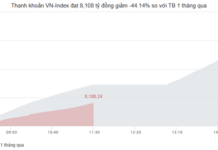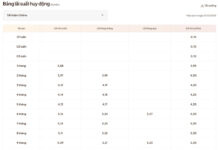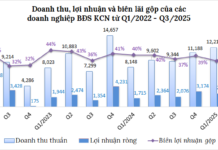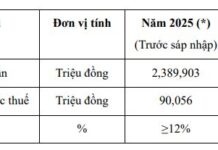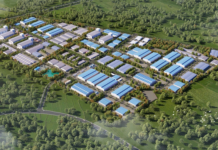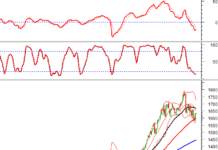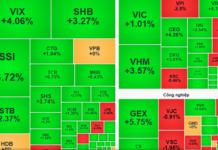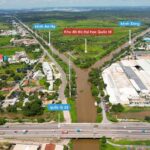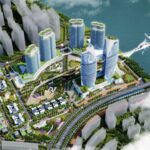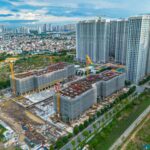
With urban land prices set to rise by 20-30% from 2026 and 70% of industrial workers still living in substandard housing, how can affordable commercial housing priced between $650 and $1,400 per square meter become the key to a sustainable urban future? The answer lies in the synchronized implementation of five advanced planning models, the establishment of a National Affordable Commercial Housing Development Fund, and a series of groundbreaking policies.
Synchronized Solutions: A Golden Opportunity for Businesses and Citizens
Affordable commercial housing not only meets 60% of the actual housing needs of young workers, technicians, and office employees but also serves as a strategic foundation for shaping the future of major cities. Unlike social housing for low-income earners priced at $300-$450 per square meter, affordable commercial housing targets families with monthly incomes of $430-$1,400, allowing free transfer and integration of modern amenities.
To address the supply-demand imbalance in affordable commercial housing, Vietnam needs a comprehensive strategy leveraging modern infrastructure, flexible mechanisms, and effective financial tools. The core of this strategy is the development of an integrated planning system, including five advanced infrastructure models: TOD, ZOD, NOD, LVC, and RULD.
TOD Model (Transit-Oriented Development) focuses on developing affordable housing projects along public transport routes like Metro Lines 1 and 2 in HCMC, the Nhon-Hanoi Railway Station line, the North-South high-speed railway, and ring roads in Hanoi and HCMC. Key areas include Thu Duc, Dong Anh, Hoa Khanh, and Can Gio, where properties near the Thu Duc metro station offer units at $950-$1,400 per square meter, allowing residents to reach the city center in 20-30 minutes. However, land prices around the Thu Duc metro station have risen by 20-30% in the past three years, necessitating a more effective LVC (Land Value Capture) mechanism.
ZOD Model (Zone-Oriented Development) focuses on housing near industrial zones and logistics ports such as VSIP III in Binh Duong, Yen Phong in Bac Ninh, Tan Duc in Long An, Phu My in Ba Ria-Vung Tau, and Dinh Vu in Hai Phong, providing convenient living for technical workers.
NOD Model (Node-Oriented Development) creates urban areas at strategic transport hubs like Long Thanh (combining airport and highways), Thu Thiem, Dong Anh, and Can Gio, integrating metro, ring roads, and seaports. A standout project is the 2,870-hectare Can Gio coastal development, featuring affordable housing, tourism, and an international seaport, connected via the Can Gio Bridge expected to complete in 2028.
LVC Model (Land Value Capture) proactively plans clean land funds around major infrastructure projects like metros, highways, airports, and seaports to reinvest in affordable housing through PPPs and land value increment mechanisms. Singapore’s successful application of this model reinvests 70% of revenue, enabling 90% of its population to own homes with loans at 2.6% per annum.
RULD Model (Rural-Urban Linkage Development) develops reasonably priced housing in suburban areas like Long An, Vinh Phuc, Tay Ninh, and Hoa Binh, effectively connected via national highways, provincial roads, and inter-regional buses. A prime example is the Ehome Southgate project in Long An, priced at $40,000 per unit, connected to HCMC via National Highway 1A within 45 minutes.
However, implementing these planning models faces significant challenges due to expected land price increases from 2026. To ensure the sustainability of the affordable commercial housing market, Vietnam must simultaneously implement three key solutions: land funds, capital, and monitoring mechanisms.
First, provide clean land funds through PPPs, avoiding auctions, or offer long-term leases of 30-50 years at preferential rates for projects meeting TOD, ZOD, NOD, and LVC criteria.
Second, establish a National Affordable Commercial Housing Development Fund with a minimum scale of $2.1 billion, raised through green bonds at 3-3.5% interest, concessional ODA from JICA and ADB at 0-1% interest, and a portion from commercial property taxes.
Third, ensure transparency of available land funds through blockchain platforms, imposing penalties of 5-10% of project value on developers delaying implementation beyond two years.
Alongside stabilizing land supply and capital, attracting business investment requires multi-dimensional incentives, from tax and finance to administrative procedures. These incentives are designed in three main groups to strongly motivate the market.
Tax incentives include a 10-year corporate income tax exemption, a 50% VAT reduction on green construction materials, and 50% support for investing in energy-saving technologies certified by standards like LOTUS and EDGE.
Financial incentives allow access to preferential loans at 4-5% per annum from the National Affordable Commercial Housing Development Fund, significantly lower than the current commercial rate of 8-10% per annum.
Administrative incentives prioritize bidding and fast-track licensing for projects applying advanced technologies like BIM, modular construction, and 3D concrete printing, reducing costs by 20-30% and shortening construction time by 40%.
Beyond facilitating businesses, the success of the affordable commercial housing market depends on citizens’ accessibility. Therefore, a comprehensive support system for homebuyers must be implemented through three core pillars: finance, information, and procedures, ensuring feasibility and sustainability.
Financial support increases access to preferential commercial loans at 3-4% per annum, with flexible repayment plans ensuring monthly payments do not exceed 30% of income, equivalent to $85-$430 per month for middle-income families.
Information transparency ensures project details, incentive policies, and construction progress are available on digital platforms like YouTube, TikTok, official websites, and blockchain applications, building trust and accessibility for young urban residents.
Procedural simplification encourages commercial banks to streamline credit approval processes, reducing processing times from 30-45 days to under 15 working days for individual homebuyers of affordable commercial housing.
Breakthrough Reforms: From Policy to Action
To remove current bottlenecks and promote the development of affordable commercial housing, a strategic component of urbanization, the government can consider implementing comprehensive reforms, synchronizing institutions, infrastructure, and investment incentives, including:
Perfecting Implementation Mechanisms and Priority Policies: While affordable commercial housing is generally regulated under the 2024 Land Law and 2023 Housing Law like other commercial housing projects, actual implementation reveals the need for more flexible execution mechanisms and specific support policies. The government should issue circulars, guidelines, and priority selection mechanisms for projects priced at $650-$1,400 per square meter, reducing approval times from 6-24 months to 3-6 months, simplifying administrative procedures, and ensuring transparency in land clearance, investment licensing, transfer, and capital mobilization. These measures will enable businesses to swiftly deploy projects in suburban areas with favorable transport infrastructure connections.
Accelerating Infrastructure Connectivity Investment: Speed up the deployment of metro lines (Hanoi, HCMC, Da Nang), the North-South high-speed railway, strategic highways (Bien Hoa-Vung Tau, North-South), ring roads (Hanoi 3, 3.5, 4; HCMC 3, 4), and key inter-provincial roads like National Highway 1A and Provincial Road 51. The goal is to ensure synchronized connectivity between affordable commercial housing in satellite cities (Can Gio, Phu My, Yen Phong, Da Nang Free Zone…) and major transport hubs like Long Thanh Airport, Noi Bai Airport, and Cai Mep-Thi Vai International Port.
Optimizing LVC Tools: Establish a transparent legal framework to attract businesses to participate in land auctions or leases around strategic infrastructure axes (metros, airports, seaports, North-South high-speed railway), while reinvesting at least 70% of land value increments into affordable commercial housing and urban utility ecosystems (schools, healthcare, parks…).
Promoting Public-Private Partnerships (PPP): Facilitate business access to preferential credit at 2-3% per annum, exempt land use taxes for 20 years for projects developed under TOD, ZOD, NOD, or RULD models. Simultaneously, the government should publicly announce available land funds, prioritizing projects using advanced construction technologies like BIM, modularization, and green materials.
Planning and Effectively Using Public Land Funds: Allocate 20-30% of public land in strategic locations like Thu Duc, Can Gio, Binh Chanh, Long Thanh, Dong Anh, and Da Nang Free Zone for affordable commercial housing development. Prioritize projects with fast construction times, green technology applications, and clear community value.
Communication & Encouraging Citizen Participation: Launch a multi-platform national communication campaign, collaborating with TikTok, YouTube, and blockchain platforms to spread the message “Settle Down and Prosper – Dreams Within Reach,” helping citizens access project information, preferential loan programs, and fast, transparent registration procedures.
2025-2030 Roadmap: From Dreams to Reality
To turn the dream of settling down into reality for millions, especially the working class and young middle-income families, Vietnam needs a well-structured, practical, and decisive action plan. The 2025-2030 period is pivotal for shaping a sustainable and synchronized affordable commercial housing market with infrastructure development.
During 2025-2027, Vietnam should focus on laying a solid foundation by perfecting the legal framework with the issuance of circulars and guidelines prioritizing the $650-$1,400 per square meter segment, simplifying procedures, and reducing approval times to 3-6 months. Establishing the National Affordable Commercial Housing Development Fund with a minimum scale of $2.1 billion, raised through green bonds (3-3.5%), concessional ODA (0-1% from JICA, ADB), and 15% from commercial property taxes, will create a robust financial resource. Planning 10-15 affordable housing urban areas integrating TOD, ZOD, NOD, and LVC models will be prioritized in strategic satellite areas like Dong Anh, Thu Duc, Long Thanh, Can Gio, Yen Phong, and Da Nang Free Zone.
Subsequently, during 2028-2030, Vietnam should accelerate large-scale development, aiming to complete 300,000 affordable commercial housing units, meeting 30% of market demand in major cities and satellite urban areas. Expanding modern infrastructure models will be concentrated in Binh Duong (VSIP III), Long Thanh, Bac Ninh (Yen Phong), Da Nang Free Zone, closely linked with metros, high-speed railways, seaports, and airports. Notably, synchronizing social utilities by integrating schools, healthcare, parks, and public transport within walking distance will move towards a smart, sustainable urban model, comprehensively serving residents.
Developing affordable commercial housing is shaping a strategic direction in creating sustainable urban areas, simultaneously solving real housing needs, improving living quality, and closely linking with infrastructure planning. This is not only the answer to the urban housing equation but also a catalyst to enhance labor productivity, stabilize the market, and spread development benefits to various social strata.
Integrated planning models like TOD (public transport linkage), ZOD (industrial zone linkage), and NOD (infrastructure hub concentration) are opening up opportunities for reasonable affordable commercial housing planning, optimizing costs, and reducing pressure on urban cores. These models not only facilitate affordable housing development but also promote smart connectivity between central and peripheral areas, forming balanced and sustainable “soft development belts.” Notably, major projects launched nationwide on August 19, 2025, have contributed to realizing integrated planning models, marking a significant step in Vietnam’s sustainable urbanization strategy.
The direction from Resolutions 66 and 68 of the Government has laid the foundation for a sustainable housing and infrastructure ecosystem, with long-term vision and specific implementation tools. Applying LVC helps effectively exploit the increased land value from major infrastructure projects like the North-South Expressway or metros, reinvesting in affordable housing and urban utilities.
Each affordable housing project implemented at the right time, place, and manner will contribute to forming humane urban areas, where living quality, connectivity, and housing accessibility are no longer privileges but foundations for an equitable, balanced, and sustainable society.
Exciting News for Hanoi’s Condo Market: Anticipated Delivery of 46,600 Units Across 43 Projects in 2026–2027
Do Thu Hang, Senior Director of Research & Consultancy Services at Savills Hanoi, suggests that substantial supply could prompt price adjustments. However, she anticipates that such adjustments will be limited to areas with abundant land availability and underdeveloped infrastructure.
Southern Real Estate Embraces Airport Corridor Urban Development
The development of Long Thanh Airport, metro lines, highways, and ring roads is reshaping Ho Chi Minh City’s urban landscape, propelling growth in satellite markets centered around integrated urban complexes, according to Dr. Nguyen Tri Hieu, a leading banking and finance expert.





